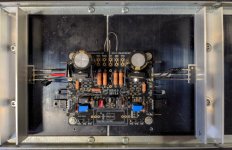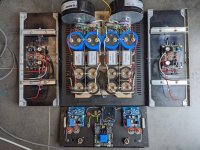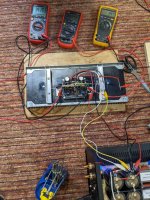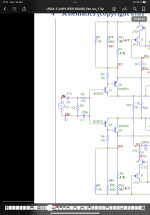Yes, the jfets are GR class,
I traced them last summer but I don't know there IDSS anymore, just that there were matched
I traced them last summer but I don't know there IDSS anymore, just that there were matched
I've a version of the USSA-5 with UMS mounting style, embedded CapMX and 8191-terminals on the way... Little covid project... If there's any interesst by you fab I could send you a pair for investigation. I won't provide gerbers for public.Hi Harry3
These are good but they take twice the space on the pcb….🙄
It would probably need an increase of USSA5 pcb size….
Fab
Correction post 🙂
Yes, the jfets are GR class,
I traced them last summer but I don't know their IDSS anymore, just that they were matched
Yes, the jfets are GR class,
I traced them last summer but I don't know their IDSS anymore, just that they were matched
Hi nfsgame
that is interesting. However, UMS is only for Pass projects I believe. Yes I can have a look at the layout since I should have some time next week.
thanks for your interest.
Fab
that is interesting. However, UMS is only for Pass projects I believe. Yes I can have a look at the layout since I should have some time next week.
thanks for your interest.
Fab
To the best of my knowledge, UMS is not only for Pass projects. I believe those mounting specs can be used freely by anyone. Given the number of Modushop chassis out in the wild with UMS heatsinks and the number of people that detest drilling and tapping ... UMS can be a very nice option.
Yes they can be used by anyone but my point is that is there is other chassis manufacturers than Modushop using the UMS at this time ?
is there other many PCB outside Pass forum following it?
Fab
is there other many PCB outside Pass forum following it?
Fab
Now I understand your phrasing => The PCBs specifically designed to be compatible with UMS are mostly Pass / First Watt designs. That is true to the best of my knowledge. 🙂
There are other projects available that are compatible with UMS. Not sure about how widely available they have been or how popular.
I have no knowledge as to whether other chassis manufacturers offer UMS as a "standard offering". I doubt it.
There are other projects available that are compatible with UMS. Not sure about how widely available they have been or how popular.
I have no knowledge as to whether other chassis manufacturers offer UMS as a "standard offering". I doubt it.
It seems that UMS heatsinks were originally produced to fit the then current DIYaudio 'shop' PCBs for Pass clone amplifiers. Since then some other designers have utilised this layout in their non-Pass clone designs, and I suspect that an increasing number of non-Pass designs PCBs will become available.
However I can't see that it is worthwhile having specialised amp. enclosures sent from Europe to the States/Canada/Australasia etc. with the cost of carriage and duty and any due taxes added to the ex. factory price.
For myself I prefer to have a local machine shop -a one-man outfit - drill and tap heatsinks. Such workers are usually a far better choice than attempting to execute the work at home using a hand drill and Amazon sourced drill bits and taps. Also enclosures are often best made from scrap alloy...again a very economic option if cut professionally and refaced by cottage industry workers. I have even found truly excellent Heatsinks in outdated sunlight converters.
Just my stingy Irish miser's half-penny worth.
However I can't see that it is worthwhile having specialised amp. enclosures sent from Europe to the States/Canada/Australasia etc. with the cost of carriage and duty and any due taxes added to the ex. factory price.
For myself I prefer to have a local machine shop -a one-man outfit - drill and tap heatsinks. Such workers are usually a far better choice than attempting to execute the work at home using a hand drill and Amazon sourced drill bits and taps. Also enclosures are often best made from scrap alloy...again a very economic option if cut professionally and refaced by cottage industry workers. I have even found truly excellent Heatsinks in outdated sunlight converters.
Just my stingy Irish miser's half-penny worth.

UMS was designed to make the chassis/drilling/tapping much simpler by having a pattern that you can design into. Yes, most of the amps are Pass designs, but that’s because those designs get PCBs made for them, (and Nelson is really prolific…) and building is greatly simplifed if you can order an off-the-shelf chassis that has all the holes drilled.
Chassis is a stumbling block for 98% of the builders in this hobby. UMS is a way that helps make it easier in many instances.
Chassis is a stumbling block for 98% of the builders in this hobby. UMS is a way that helps make it easier in many instances.
Hi Folks
After building a new tube preamp I pulled out my f5 turbo monoblocks and put a 11w BHel84 tube power amp in the system. It sounded pretty nice but lacked dynamics in the bass with my 4 ohms 88db speakers. Looking to try something more powerful, I dug out my USSA5 and checked offset and bias, which were OK, and did some work to improve air flow around the internal heat sinks.
I am really pleased with the performance of this amp. It is the first time with USSA5 connected to my main system. My amp is built with a large +-28v LC filtered power supply and will put out about 60w class AB into 4 ohms. The USSA5 seems to nicely complement the tube preamp. Dynamics and soundstage are excellent and I am really enjoying both digital and analog playback through the system.
Thank You Fab for developing this design and generously bringing it to DIYAudio
Regards
Brian
After building a new tube preamp I pulled out my f5 turbo monoblocks and put a 11w BHel84 tube power amp in the system. It sounded pretty nice but lacked dynamics in the bass with my 4 ohms 88db speakers. Looking to try something more powerful, I dug out my USSA5 and checked offset and bias, which were OK, and did some work to improve air flow around the internal heat sinks.
I am really pleased with the performance of this amp. It is the first time with USSA5 connected to my main system. My amp is built with a large +-28v LC filtered power supply and will put out about 60w class AB into 4 ohms. The USSA5 seems to nicely complement the tube preamp. Dynamics and soundstage are excellent and I am really enjoying both digital and analog playback through the system.
Thank You Fab for developing this design and generously bringing it to DIYAudio
Regards
Brian
Hey fab,Hi nfsgame
that is interesting. However, UMS is only for Pass projects I believe. Yes I can have a look at the layout since I should have some time next week.
thanks for your interest.
Fab
I've sent you some drafts via E-Mail.
Hi BrianHi Folks
After building a new tube preamp I pulled out my f5 turbo monoblocks and put a 11w BHel84 tube power amp in the system. It sounded pretty nice but lacked dynamics in the bass with my 4 ohms 88db speakers. Looking to try something more powerful, I dug out my USSA5 and checked offset and bias, which were OK, and did some work to improve air flow around the internal heat sinks.
I am really pleased with the performance of this amp. It is the first time with USSA5 connected to my main system. My amp is built with a large +-28v LC filtered power supply and will put out about 60w class AB into 4 ohms. The USSA5 seems to nicely complement the tube preamp. Dynamics and soundstage are excellent and I am really enjoying both digital and analog playback through the system.
Thank You Fab for developing this design and generously bringing it to DIYAudio
Regards
Brian
thank you for your feedback and appreciation.
Hi Danny
I second Vunce in his comment!
Do not forget to install the screw to have the drivers making good contact with the heatsinks.
Good luck with the rest and happy new year to come.
Fab
I second Vunce in his comment!
Do not forget to install the screw to have the drivers making good contact with the heatsinks.
Good luck with the rest and happy new year to come.
Fab
Hi Fab,
I'm busy with setting the bias, so far I needed to change the resistors R5 and R6 from 2.2k to 2.7k,
otherwise I couldn't get the bias higher than 1A.
Resistors for the drivers will be about 57R and 35R,
the cardboard is for putting pressure on the driver resistors that I plug in (no soldering), fast and easy to determine the values 🙂
I'm busy with setting the bias, so far I needed to change the resistors R5 and R6 from 2.2k to 2.7k,
otherwise I couldn't get the bias higher than 1A.
Resistors for the drivers will be about 57R and 35R,
the cardboard is for putting pressure on the driver resistors that I plug in (no soldering), fast and easy to determine the values 🙂
Attachments
Hi Danny
I am confused since R5/R6 are 10k ohms each on the schematics and BOM. Only in USSA-5B version the R5/R6 value is lower in the 1K and 3K range….
Can you clarify. You can send me all your measurements taken at each step and I can double check them.
Fab
I am confused since R5/R6 are 10k ohms each on the schematics and BOM. Only in USSA-5B version the R5/R6 value is lower in the 1K and 3K range….
Can you clarify. You can send me all your measurements taken at each step and I can double check them.
Fab
Attachments
Hi Fab,
It's the USSA-3 that I'm building with 2SK170GR and 2SJ74GR
I'm using the doc "USSA-33 AMPLIFIER BOARD Fab rev07.pdf"
R5 and R6 at 2.7K is just enough to get 1.2A, but not for 1.3A
then I need to change the pot, and thermistor R7/R8
or put a resistor in series of 500 before this block? see red markings that I added:

It's the USSA-3 that I'm building with 2SK170GR and 2SJ74GR
I'm using the doc "USSA-33 AMPLIFIER BOARD Fab rev07.pdf"
R5 and R6 at 2.7K is just enough to get 1.2A, but not for 1.3A
then I need to change the pot, and thermistor R7/R8
or put a resistor in series of 500 before this block? see red markings that I added:
Last edited:
- Home
- Amplifiers
- Solid State
- USSA-5 Build with Review



